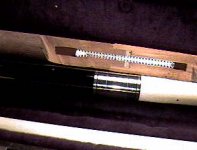You are using an out of date browser. It may not display this or other websites correctly.
You should upgrade or use an alternative browser.
You should upgrade or use an alternative browser.
Production cue A-joint
- Thread starter JoeyInCali
- Start date
JoeyInCali said:Brand starts with an S.
The top one with exposed joint.
A retired maker sent me this.
I wonder if there is a reason, that this Qmaker didn't bottom out the screw, on either end?...JER
An "S"?? Is this a single cuemaker or someone who works with others aswell???JoeyInCali said:Brand starts with an S.
The top one with exposed joint.
A retired maker sent me this.
High end production.Craig Fales said:An "S"?? Is this a single cuemaker or someone who works with others aswell???
What's equally disturbing to me is the apparent absence of epoxy. Come on guys, the stuff's not that expensive.
The diagonal flat at the bottom of the pin that would normally lock the pin in place when covered with epoxy becomes useless. Also, the voids wouldn't be such a problem if they were filled with epoxy.
The diagonal flat at the bottom of the pin that would normally lock the pin in place when covered with epoxy becomes useless. Also, the voids wouldn't be such a problem if they were filled with epoxy.
KJ Cues said:What's equally disturbing to me is the apparent absence of epoxy. Come on guys, the stuff's not that expensive.
The diagonal flat at the bottom of the pin that would normally lock the pin in place when covered with epoxy becomes useless. Also, the voids wouldn't be such a problem if they were filled with epoxy.
On any pin or bolt that I use in a cues construction I grind a flat at least 1/3 of the way through the bolt. i do this so that when the bolt nears the bottom of the hole, where the threads are not complete or as pronounced as the rest of the threads, this flat will act as a bottoming tap to chase these threads. I also either mill a flat or cut a groove on the band saw, along the entire length of the connection stud to act as a glue relief. Nothing is more irritating than to waste a good looking piece of wood by cracking through hydraulic action. As you said, glue is cheap and I want to insure my cues will never fail from a lack of it.
I also only use cadmium coated steel or aluminum studs as A-joint studs. You can buy an 8' length of cold rolled threaded rod for about the same price as a two foot piece of the coated steel but the cold rolled has been oil soaked and I don't want to take the chance of not getting all of the oil off and then having glue failure.
Dick
Last edited:
On any pin or bolt that I use in a cues construction I grind a flat at least 1/3 of the way through the bolt.
tap tap tap
tap tap tap
dave sutton
Banned
prob has 100,000$ in CNC equipt and cant even put a cue together right.
i have my taps and bits marked off to ensure everything is snug. and if it isnt (maybe a hair gap) i use a great deal of epoxy anyway to fill that.
guess it quanity not quality these days
i have my taps and bits marked off to ensure everything is snug. and if it isnt (maybe a hair gap) i use a great deal of epoxy anyway to fill that.
guess it quanity not quality these days
dave sutton
Banned
Fish said:air pressure ???
when you slap a bunch of epoxy in the holes then screw the joint together air gets trapped in the pockets. i guess the epoxy makes it air tight. when the parts are perfect like we are talking about there is only one place for that air to go. usually ends up cracking the wood to escape and your work is for nothing that why glue relief holes or notches are important besides providing some extra grab
Start with an "S" and is high end, could it be "Schon"?
dave sutton
Banned
thats what i thought but i dont wana say it
joey just wondering what made him cut this cue up like this???
joey just wondering what made him cut this cue up like this???
He didn't have an x-ray machine and wondered how the cue was made.dave sutton said:thats what i thought but i dont wana say it
joey just wondering what made him cut this cue up like this???
Cuemaster98 said:Start with an "S" and is high end, could it be "Schon"?
Looking at the joint it appears to be a wood pilot with a SS sleeve. So it could be a Shuler. Schon uses a solid type SS joint
We're talking about the A joint here...TheBook said:Looking at the joint it appears to be a wood pilot with a SS sleeve. So it could be a Shuler. Schon uses a solid type SS joint
